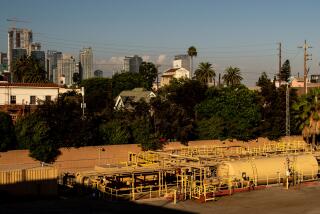Petunia Has Been Good to Oklahoma
- Share via
OKLAHOMA CITY — Gov. George Nigh grinned as he stood beside the Petunia No. 1 oil well on the grounds of the state Capitol. “No other governor has this kind of luxury,” he declared.
Oklahoma claims to have the only Capitol in the world sitting on a producing oil field. Millions of barrels of crude have been recovered since drilling began 44 years ago, pumping several million dollars in royalties and taxes into the state’s coffers.
At one time there were two-dozen wells, going as deep as 1 miles for the oil and gas under the grounds surrounding the six-story, granite-and-limestone Capitol. But the oil has been depleted and now the only remaining well is Capitol Site No. 1, as Phillips Petroleum refers to it. But all over Oklahoma, it’s known as Petunia, taking its nickname from the petunia patch that covered the area where the well was dug.
That one well has produced 1,576,923 barrels of oil since it came in on Nov. 10, 1941, and has paid the cost of the Capitol many times over, said Jerry Smith, spokesman for Phillips Petroleum. Millions of dollars more poured into the state treasury from the other wells.
State officials said there are no estimates of the total fortune generated from the Capitol wells, because several oil companies have been involved in the recovery and records of royalty payments have not been kept in one place. For instance, Phillips has partners in Petunia. It operates the well and has a 50% interest its lease, while Sun and Gulf Oil each have a 25% share.
“Oil and gas are extremely important to the state,” with production continuing in 72 of the state’s 77 counties, Nigh said. “Direct taxes on the petroleum industry account for 29% of Oklahoma’s total sales tax collection. In this state, 80,000 men and women are employed in the petroleum industry.”
Any drop in oil prices has a profound impact on Oklahoma, he pointed out. Indeed, it was the falling price of oil that led to the collapse in 1982 of Oklahoma’s Penn Square Bank, one of the most spectacular bank failures in the country’s history.
“For every dollar the price of oil drops, the state loses $11 million out of the general fund.” he said.
Oklahoma ranks fifth among the states in oil production, producing 5% of the nation’s total yield. Present production in the state is 437,000 barrels a day.
Oklahoma City became one of the nation’s major oil-producing areas--it ranks eighth nationally among producing oil pools--when the Mary Sudick well came in on Dec. 4, 1928. During the first 40 years, the field yielded 733.5 million barrels of oil.
“I’m sure other governors are envious,” Nigh allows. “These wells under the state Capitol help two ways--pumping royalties into the state coffers and as a tourist attraction. You’d be amazed to see the number of people every day snapping pictures of the oil wells with the Capitol behind them.”
More to Read
Sign up for Essential California
The most important California stories and recommendations in your inbox every morning.
You may occasionally receive promotional content from the Los Angeles Times.












